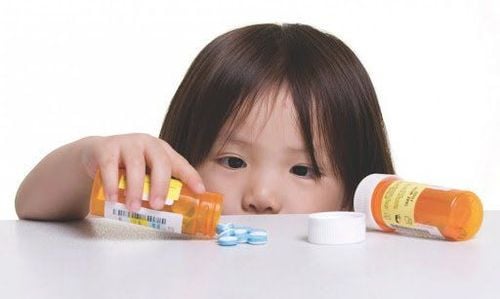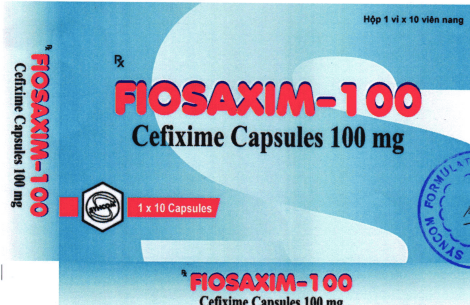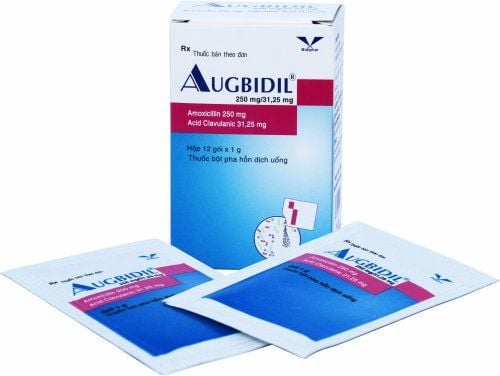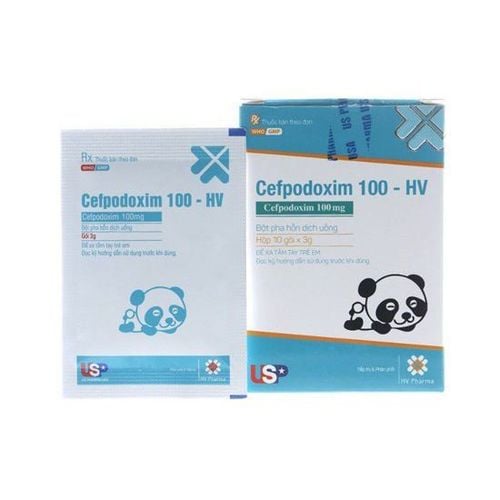This is an automatically translated article.
Uphaxime drug is made in the form of hard capsules, with the main ingredient being Cefixime. The drug is used to treat a number of bacterial infections: otitis media, pharyngitis, bronchitis, nephritis - pyelonephritis,...
1. Uses of the drug Upaxime
1 Uphaxime 200 tablet has the main ingredient of 200mg Cefixime (as Cefixime trihydrate) and other excipients. Cefixime is an antibiotic belonging to the 3rd generation cephalosporin group. The drug has a good effect on gram-negative bacteria strains, is stable to beta-lactamases and achieves bactericidal concentrations in the cerebrospinal fluid. However, on gram-positive bacteria, Cefixim is less effective than first-generation penicillins and cephalosporins. It is also effective against P. aeruginosa.
Indications for use of Uphaxime:
Treatment of uncomplicated urinary tract infections, caused by drug-sensitive strains of bacteria such as E. coli or Proteus mirabilis and some other gram-negative bacilli such as Enterobacter spp., Klebsiella spp., Citrobacter spp., Proteus spp; Treatment of some cases of pyelonephritis and complicated urinary tract infections, caused by susceptible Enterobacteriaceae; Treatment of otitis media caused by Moraxella catarrhalis (including beta-lactamase-producing strains), Haemophilus influenzae (including beta-lactamase-producing strains), Streptococcus pyogenes; Treatment of tonsillitis and pharyngitis caused by Streptococcus pyogenes; Treatment of mild and moderate community-acquired pneumonia; Treatment of acute and chronic bronchitis caused by Haemophilus influenzae, Streptococcus pneumoniae or Moraxella catarrhalis; Treatment of uncomplicated gonorrhea caused by Neisseria gonorrhoeae (including beta-lactamase-producing strains), typhoid caused by Salmonella typhi (including multidrug-resistant strains) or Shigella-susceptible dysentery (including strains resistant to ampicillin). Uphaxime is contraindicated in patients with a history of hypersensitivity to Cefixime, other cephalosporin antibiotics or a history of penicillin-induced anaphylaxis.
2. Usage and dosage of Uphaxime
Usage: Orally. Should take the drug Uphaxime after eating, drink with boiled water to cool.
Dosage:
Adults: The usual dose is 2 tablets/day, can be used 1 or 2 times (12 hours apart); Children over 12 years old or weighing over 50kg: Use the same dose as adults; Children under 6 months of age: The safety and effectiveness of Uphaxime have not been verified for this group of people; Patients with renal impairment: If the patient's creatinine clearance is less than 20ml/min, the dose is 1 tablet/day. Duration of taking Uphaxime: Depending on the type of infection, patients should extend treatment with Uphaxime for an additional 48 - 72 hours after the symptoms of infection have disappeared. The usual duration of treatment for upper respiratory tract infections is 5 to 10 days (if beta-hemolytic Streptococcus group A is to be treated, at least 10 days should be treated to prevent rheumatic fever). The duration of treatment for uncomplicated urinary tract infections is 5 - 10 days; Lower respiratory tract infections and otitis media are 10-14 days.
Overdose: When using the drug Uphaxime overdose, patients may have symptoms of convulsions. Since there is currently no specific treatment for this condition, treatment is mainly symptomatic. When the patient has symptoms of overdose, it is necessary to stop the drug immediately and treat it by: gastric lavage, possibly using anticonvulsant drugs (if clinically indicated). Since Uphaxime is not eliminated by hemodialysis, neither peritoneal dialysis nor hemodialysis is effective.
Missed dose: Uphaxime should be used as soon as possible, it can be used about 1-2 hours after the doctor prescribed. If you miss a dose of Uphaxime for too long, it is almost time for the next dose, the patient should skip the missed dose and use the next dose as usual, no need to make up for the dose.
3. Side effects of the drug Upaxime
Cefixime is generally well tolerated, side effects are usually mild to moderate, transient. When using Uphaxime, patients may experience some side effects such as:
Common: Digestive disorders: Nausea, vomiting, flatulence, abdominal pain, dry mouth, loss of appetite, diarrhea and vomiting. broken feces. Gastrointestinal disturbances usually occur in the first 1-2 days of treatment with the drug. These conditions all respond well to symptomatic medications, so patients rarely need to stop taking them; Nervous system: Dizziness, headache, insomnia, restlessness, fatigue; Hypersensitivity: Erythema, urticaria, drug fever; Uncommon: Gastrointestinal: Severe diarrhea caused by Clostridium difficile, pseudomembranous colitis; Hematology: Leukopenia, thrombocytopenia, transient eosinophilia, decreased hematocrit and hemoglobin levels; Systemic: Angioedema, anaphylaxis, erythema multiforme, Stevens - Johnson syndrome, toxic epiglottitis; Liver: Jaundice, hepatitis, transient increase in ALT, AST, bilirubin, alkaline phosphatase and LDH; Renal: Temporary increase in non-protein blood nitrogen, transient increase in plasma creatinine concentration, acute renal failure; Other side effects: Vaginitis, vaginal candidiasis; Rare: Hematology: Prothrombin time prolongation; Body as a whole: Convulsions. Patients should inform their doctor about the side effects encountered when using Upaxime for advice and support on the most effective treatment.
4. Be careful when using the drug Upaxime
Before starting treatment with Cefixime, it is necessary to carefully investigate the patient's history of allergy to penicillin and other cephalosporins; Uphaxime should be used with caution in patients with a history of gastrointestinal disease and colitis, especially during prolonged use. This is because Cefixime can overgrow resistant strains of bacteria (especially Clostridium difficile in the intestines causing severe diarrhea). In this case, the drug should be stopped and treated with another antibiotic. In addition, diarrhea in the first 1-2 days is mainly due to medication. If diarrhea is mild, it is not necessary to stop taking Upaxime; Dosage and frequency of administration of Uphaxime need to be reduced in patients with renal impairment (including patients on extra-renal dialysis) because plasma concentrations of cefixime in patients with renal impairment are often higher and longer lasting than those with renal failure. people with normal kidney function; There are no data on the safety and efficacy of Upaxime in children under 6 months of age; Elderly patients using Uphaxime generally do not need to adjust the dose, unless there is impaired renal function (creatinine clearance less than 60ml/min); To date, there are no adequate data on the effects of Cefixime on pregnant women. Therefore, Uphaxime should only be used in this subject when absolutely necessary and approved by the doctor; It is not known whether Cefixim passes into breast milk. Therefore, Uphaxime should only be used in lactating women with caution, breastfeeding may be temporarily discontinued during its use; Cefixime may cause some side effects such as dizziness, headache, restlessness, fatigue, ... so caution should be exercised when using Uphaxime in drivers, operating machinery.
5. Uphaxime drug interactions
Some drug interactions of Uphaxime include:
When using Probenecid with Uphaxime concurrently, Probenecid increases the peak concentration and AUC of Cefixime, reduces the renal clearance as well as the volume of distribution of the drug; Concomitant use of Uphaxime with anticoagulants such as Warfarin may increase prothrombin time, with/without bleeding; When taking Uphaxime together with Carbamazepine may increase the concentration of Carbamazepine in the blood plasma; Concomitant administration of Uphaxime and nifedipine may increase the bioavailability of Cefixime, manifested by an increase in peak concentrations and AUC. To enhance and maximize the effects of Upaxime, patients should take the drug at the right dose and according to the schedule prescribed by the doctor. In addition, patients should combine with a healthy, scientific diet, combined with daily exercise and sports,...
Follow Vinmec International General Hospital website to learn more lots of health, nutrition, and beauty information to protect the health of yourself and your loved ones in your family.
Please dial HOTLINE for more information or register for an appointment HERE. Download MyVinmec app to make appointments faster and to manage your bookings easily.













